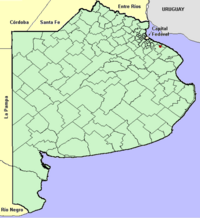La Plata
| La Plata | |||
 |
|||
|
|||
 La Plata
|
|||
| Coordinates: | |||
| Country | |||
|---|---|---|---|
| Province | |||
| Partido | La Plata | ||
| Founded | 19 November 1882 | ||
| Elevation | 26 m (85 ft) | ||
| Population (2001 census [INDEC]) | |||
| - Total | 690,616 | ||
| CPA Base | B 1900 | ||
| Area code(s) | +54 221 | ||
La Plata is the capital city of the province of Buenos Aires, Argentina, as well as of the partido of La Plata. The city was planned to serve as the capital of the province after the city of Buenos Aires was declared as the federal district in 1880. Per the 2001 census [INDEC], the city proper has a population of 574,369 and its metropolitan area has 694,253 inhabitants.

La Plata was officially founded by Governor Dardo Rocha on November 19 1882 and its construction was fully documented in photographs by Tomás Bradley Sutton.[1]
Its current mayor is Pablo Bruera.
It was referred to as Eva Perón City ("Ciudad Eva Perón") between 1952 and 1955.
Contents |
History and brief description



Rocha decided to erect a new city to host the provincial government institutions and the planned university. Urban planner Pedro Benoit designed a city layout based on a rationalist conception of urban centers. The city (see figure) has the shape of a square with a central park and two main diagonal avenues, north-south and east-west. (In addition, there are numerous other shorter diagonals.) This design is copied in a self-similar manner in small blocks of six by six blocks in length. Every six blocks, one finds a small park or square. Other than the diagonals, all streets are on a rectangular grid, and are numbered consecutively. Thus, La Plata is nicknamed "la ciudad de las diagonales" ("city of diagonals"). It is also called "la ciudad de los tilos" ("city of tilia (linden tree)") because of the large number of linden trees lining many streets and squares.
The city design and its buildings are said to possess a strong Freemason symbolism. This is said to be a consequence of both Rocha and Benoit being Freemasons.
The designs for the government buildings were chosen in an international architectural competition. Thus, the Governor Palace was designed by Italians, City Hall by Germans, etc. Electric street lighting was installed in 1884, and was the first of its kind in Latin America.
The cathedral of La Plata, in neo-Gothic style, is the largest church in Argentina.
The Curutchet House is one of the two buildings by Le Corbusier in the Americas. The Teatro Argentino de La Plata is the second most-important opera house in Argentina after the Teatro Colon in Buenos Aires.
The La Plata University was founded in 1897 and nationalized in 1905. It is well-known for its observatory and paleontology museum. Ernesto Sabato graduated in physics; he went on to teach at the Sorbonne and the MIT before becoming a famed novelist. Doctor René Favaloro was another famous alumnus. During its early years, it attracted a number of renowned intellectuals from the Spanish-speaking world, such as Dominican Pedro Henriquez Ureña.
Under Alvear's administration (1922-1928), Enrique Mosconi, the president of the oil state company Yacimientos Petrolíferos Fiscales, created the distillery of La Plata, which was the tenth largest in the world [2].
The city was renamed in 1952 as Eva Perón; the original name was restored in 1955.
The city is home to two football (soccer) teams that play in the first division: Estudiantes de La Plata and Gimnasia y Esgrima La Plata.

Climate
Usually warm and humid in the summer. Mild winters.
Average temperature: 16.3°C
Average clear days: 126 Rain: 1023 Mn
Average humidity: 78%
People

See Cat:People from La Plata
Sister Cities
 Beersheba, Israel
Beersheba, Israel Louisville, United States
Louisville, United States Montevideo, Uruguay
Montevideo, Uruguay Liverpool, England
Liverpool, England Porto Alegre, Brazil
Porto Alegre, Brazil
References
- ↑ Thomas Bradley: The photographer of Dardo Rocha (in Spanish)
- ↑ Felipe Pigna, Los Mitos de la historia argentina, 3, ed. Planeta Historia y Sociedad 2006, p.153
External links
- (Spanish) Official government website
- (Spanish) http://www.mapa.laplata.gov.ar Interactive Map of La Plata
- (Spanish) Municipal information: Municipal Affairs Federal Institute (IFAM), Municipal Affairs Secretariat, Ministry of Interior, Argentina.
- (Spanish) http://www.laplatamap.com.ar Commerce guide of La Plata
|
|||||||
|
|||||||||||
